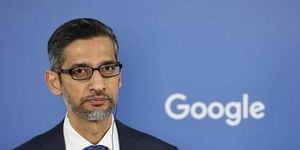CINCINNATI — Vivek Ramaswamy officially launched his campaign for governor of Ohio on Monday, energized by the crowd at CTL Aerospace, declaring, “America is back, and it feels fantastic.” The 39-year-old biotech entrepreneur and former GOP presidential candidate is stepping onto the political stage once again, seeking to succeed the term-limited Republican Governor Mike DeWine.
Ramaswamy, who gained national recognition during his 2024 presidential bid, is entering what promises to be a competitive Republican primary. He joins Ohio Attorney General Dave Yost, who also announced his candidacy last month, as well as Heather Hill, a former Morgan County school board president. On the Democratic side, former Ohio Department of Health Director Dr. Amy Acton is gearing up for the race.
During his campaign kickoff, Ramaswamy outlined his vision for Ohio's future and positioned his candidacy within the broader framework of the Trump administration's objectives. “It was a fork in the road,” Ramaswamy remarked, reflecting on Trump’s reelection prospects. He expressed optimism about America’s future, stating, “We’re on the cusp of a new golden age in America right now.”
The rally emphasized Ramaswamy’s commitment to rebuilding Ohio as a hub for business and families, pledging to transform the state by making it the top destination for startups and family life. “I will lead Ohio to be the top state in the country to start and grow a business,” he proclaimed. He also vowed, “I will lead Ohio to be the top state where our kids get a world-class education,” emphasizing his plans to empower youth with the skills to succeed.
His remarks were heavily infused with his critique of government regulations and social policies. Ramaswamy called out excessive regulations, vowing to “shred every excess regulation” if elected governor, and proposed severe cuts to state governance. This approach mirrors the views he championed during his time running for president, where he advocated for significant cuts to federal bureaucracy.
While discussing important social issues, Ramaswamy insisted on the need to address what he termed the “war on work.” He criticized the absence of Medicaid work requirements, stating, “It’s not compassion to make somebody more dependent on the government. The compassionate thing to do is to help them achieve their independence from it.” This sentiment aligns with his promise to implement merit-based pay for public schoolteachers and maintain rigorous standards across educational platforms.
Ramaswamy’s entry follows his recent role with the Department of Government Efficiency (DOGE), which he co-chaired with Elon Musk before resigning on the day Trump was inaugurated. Though his brief tenure raised eyebrows, it helped cement his connections within the Republican establishment, where he already claims key endorsements from notable state officials, including Secretary of State Frank LaRose and State Treasurer Robert Sprague.
His connections enable Ramaswamy to present himself as part of the political elite of Ohio, having grown up near Cincinnati. This raises questions about his ability to resonate with the broader voter base, particularly those who might see his business background and experience as detached from the realities faced by everyday Ohioans.
Opponents have already begun to sharpen their critiques. Acton, the leading Democratic candidate, remarked, “It’s clear, Vivek Ramaswamy does not know the same Ohioans I do,” hinting at potential weaknesses concerning Ramaswamy’s outsider status and his perceived disconnect with local issues.
Polling data indicates Ramaswamy is already appealing to Republican primary voters, boasting over 50% support within the party against Yost, who he trails by 34 points. Ramaswamy's history of successfully traversing national political landscapes could provide him with the momentum needed to garner voter interest within Ohio’s grassroots levels.
Political analysts contend Ramaswamy's campaign could mark another significant shift for Ohio, which has traditionally been viewed as a swing state but has trended more Republican under Trump. His position may also set the stage for broader Republican challenges to the long-held Democratic strategies within the state.
Ramaswamy closed his speech with calls for unity, emphasizing the need for coalition-building within the Republican Party. He expressed his intent to bring together diverse factions, from Reagan Democrats to libertarians, under what he refers to as “a big tent coalition.” The 2026 gubernatorial race is shaping up to not only be about state governance but potentially about the future direction of the GOP itself.
Looking forward, Ramaswamy’s path will not be easy. With competitors like Yost and the potential entrance of popular figures such as Jim Tressel, fans of the former Ohio State University football coach, he will need to navigate both the immediate challenges of the Republican primary and the larger ideological battles reflective of the national GOP agenda.
Ohio remains central to both national and statewide political strategies, so Ramaswamy's bid is not just about winning the governorship; it is about influencing the direction of conservative politics at large. Whether Ramaswamy can galvanize sufficient support among Ohio’s diverse electorate will become evident as the campaign progresses toward the 2026 election.



